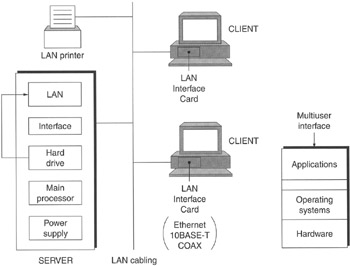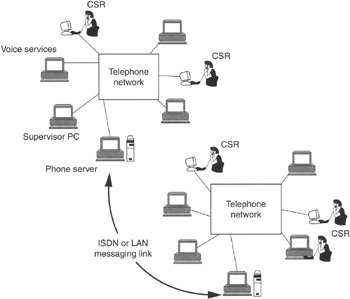2.2 Network structures and CTI servers
|
|
2.2 Network structures and CTI servers
A network structure is made up of several components—client computers and servers consisting of transport mechanisms—forming a physical interface and network architecture. Some examples of network architectures are Ethernet, 10BASE-T, Token Ring, and ATM (asynchronous transfer mode). A communications protocol (TCP/IP or SPX/IPX (sequenced packeteXchange/internetwork packeteXchange)) is also required to link the elements of a network. Each PC on the network has a LAN card to provide an interface to the network.
The server is a device that empowers the network and the attached users. There are several types of servers in LAN environments: file and print servers, departmental database servers, and legacy hosts acting as database servers. CTI introduces a new class of servers to the LAN infrastructure—telephony servers. (see Figure 2.5) Server platforms generally consist of the same basic hardware as the desktop PC but have some differences in operating characteristics. Generally, they are faster, more powerful, and have much more memory and disk space. They come in a variety of configurations and levels of robustness, depending on their intended use and the importance of maintaining data integrity or network connections. Telecom servers are a special class of telephony servers that deliver high bandwidth and require higher-capacity buses. These devices are described in more detail later in this chapter. (see Figure 2.6)

Figure 2.5: LAN server architecture.

Figure 2.6: Telecom server architecture.
As the LAN industry matured, developers started designing network-based applications that could be used in a network environment by many clients simultaneously. These applications are tolerant of delays imposed by multiuser access and led to the development of network operating systems: Novell NetWare, IBM LAN Manager, and Microsoft MS Windows NT.
Communications in the call center
There are a number of different telephone operating models, all of which may have a role in call center operations. The communications environment chosen for a call center will be related to the call volumes anticipated, number of seats in the center, and the geographical extent and coverage of the call center. Two of the most popular communication models are described in this section:
-
Public network
-
Customer premise
Public network model
The most important telephony elements related to CTI are services provided by public telephone networks and the capabilities of call processing and call control. The world's public telephone networks are complex, with millions of endpoints hard-wired and connected through thousands of central connecting points called central offices (COs). The public network has evolved over the years from its POTS (plain old telephone service) analog beginnings to the broad range of advanced, sophisticated services provided by today's digital technology. (see Figure 2.7)

Figure 2.7: Routing calls in the network.
The public network model has relatively simple communications architecture. Users with a "terminal device," such as a telephone, are connected by the network to a service provider—actually, a server. Once connected, the user can ask for any of the wide range of services generally available—from dialing a number to directory assistance or voice messaging. In general, the network operator or service provider can change or enhance capabilities without disrupting existing services. This model is present in many telecommunications environments. As a terminal device, a telephone handset has many variations. It may be analog or digital, with buttons and displays, and it can also be wireless. Terminal devices also include fax machines, modems, video phones, alarm systems, WAN equipment, and multimedia boards for PCs. Broadly defined, a terminal device is "any piece of hardware attached to the network, and capable of accessing the service provider."
The basic network infrastructure resembles a giant spider web, consisting as it does of a set of switches (the central offices referred to previously) interconnected by a variety of transmission media—fiber-optic cable, satellites, radio, underwater cables, and so on. In the public network circuit-switched service, a call is connected across the network and travels a number of different paths to get to its destination. The most basic service is the telephone call. The sequence of events is as follows:
-
The user picks up the phone (goes off-hook), which gets the attention of the network.
-
The user then dials a string of digits (which the network recognizes as an address).
Hidden from the user is all the logic for routing the call through the network, handling exceptions (such as routing invalid numbers to a recording), or invoking special features. This logic is delivered by a service provider attached somewhere within the network—again invisible to the user, other than through prerecorded messages.
In the public network, along with basic call-handling services there are a range of supplementary services available, the most popular being ANI and DNIS. ANI (automatic number identification) is the ability of the network to identify the calling number. With ANI, the user knows who is calling before answering. DNIS (dialed number information service) is the ability of the network to identify the number that was dialed to reach a user. These two features are important in call center operations.
Customer premise model
As the telephone became a must-have business and management tool, the logistics and costs associated with adding a new telephone line for every new employee or every new phone became overwhelming. Customer premise equipment (CPE) was developed to overcome these problems; it falls into two categories:
-
Access points to network services
-
Extensions of the network itself
The following two examples illustrate the differences:
Key systems (access products)
For small businesses requiring several telephone lines, the key system provides the user with direct access to the network line corresponding to that key. Other users are provided with a small light or "busy lamp" to indicate when a line is busy.
Private branch exchange (PBX)
In large businesses, smaller versions of central office switches, called private branches or PBX systems, enable hundreds or thousands of employees to handle the volume of internal calls. As well, they can share access lines to the network and provide operator services.
For very large corporations with multiple buildings or sites, complete private networks may be installed to carry internal traffic as well as to interconnect to the public network at strategic points to get the best geographic coverage for the lowest cost.
Telecom switching systems
The following elements are found in all telecom switching systems:
-
Operating system software that controls the hardware
-
Call processing software that makes connections, provides features, and delivers services
-
Line side interfaces connecting the switch to the end-user telephone set
-
Trunk side interfaces connecting the customer's switch to the network
-
A switching fabric linking the various interfaces
Operating system software
In the telecommunications environment as in the world of computing, hardware is controlled by operating system software. The telecom environment has special needs for multiuser, real-time, fault-tolerant operating systems. The complexities of the features available have resulted in switch products that use proprietary operating systems, a parallel to the proprietary legacy systems of the computing environment.
Call processing applications
The heart of a modern switching system is a set of software applications known collectively as call processing. This software provides all the functionality seen by the user—from the basic call setup to delivering caller ID. This software also provides user features (such as call forwarding), enhanced network services (such as least-cost routing), and specialized call handling for call centers. Call processing is the basis for powerful CTI applications that can make a call center highly effective and productive.
Interfacing hardware
Modern telecom systems operate by converting analog voice signals into a digital format known as pulse code modulation (PCM). The digital format is far superior for clear transmission, storage, compression, and even encryption. This process is accomplished by a silicon chip, a CODEC (for code and decode) designed into the line interface. The CODEC samples the voice signal 8000 times per second and transforms it into the digital signal, ready for transmission. At the other end, another CODEC chip transforms the digital signal into a recognizable voice signal.
The switching device performs the function of connecting the digital signal from the line interface to the destination, which might be another line interface (intercom call), a trunk interface (network call), or a common resource (such as a conference bridge). Once established, the connection stays up for the duration of the call. The trunk interface is a shared pipe into the public network. There are various types of trunk interfaces, defined by their bandwidth capacities—T1, T2, T3. For example, a single T1 trunk provides 24 circuit paths for digitized voice as well as the signaling to access the network services. Typically, these 24 circuits can provide service to about 150 users.
|
|
EAN: 2147483647
Pages: 90